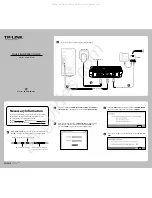
ISDN Router Manual V.1.1
27
5.4.3 Configure BOD (Bandwidth On Demand)
config interface isdn ppp bod incre <increase> decre <decrease>
Set bandwidth-on-demand to router.
By default BOD is enabled on the router.
Bandwidth on Demand (BOD) is a feature that allows the second telephone line connection
to the internet to be made only if there is enough traffic between the router and the internet -
which exceeds the capacity of the first telephone line connection. Since it is likely that there
are many periods of little activity where there may be no data to be sent between the router
and the internet, this feature helps the user to save a considerable amount on connection with
the ISDN phone line.
To enable BOD (throughput BOD) enter the following command at the CLI prompt:
>
config int isdn ppp bod incre 80 decre 20
This tells the router that it should bring up the second telephone line connection when the
traffic level on the first telephone line exceeds 80% of its capacity. At the same time if the
traffic level on the first telephone line connection drops below 20% of its capacity, the
second telephone line connection should be terminated.
To disable BOD, i.e., if you don’t want the second telephone line connection to be brought
down even if there is no traffic on the line, enter the following command:
>
config int isdn ppp bod decre 0
The other BOD function (resource BOD) acts as voice priority first manner. When the router
connected by 2B channels (ML-PPP), if you want to place an outgoing voice call, the router
will automatically drop 1B channel for your dialing to the destination. As soon as you hang up,
the router will automatically connect the second B channel again to return ML-PPP connection.
The same mechanism works also under ML-PPP connection: If someone made a voice call to
the router, it will drop 1B channel to accept the call and ring TEL-A or TEL-B. As soon as the user
hang up, the router will again connect the second B channel and back to ML-PPP.
















































